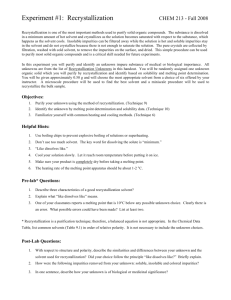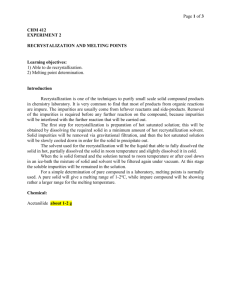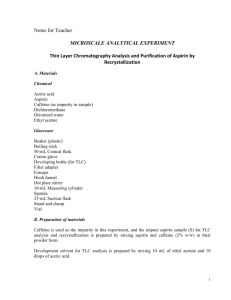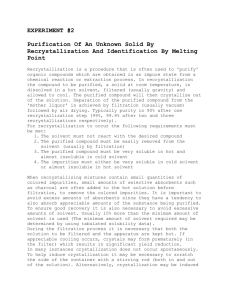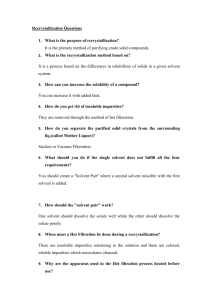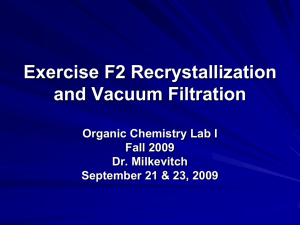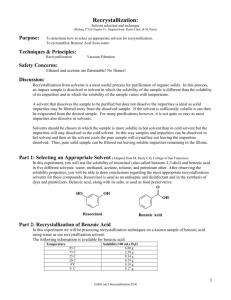Recrystallization
advertisement
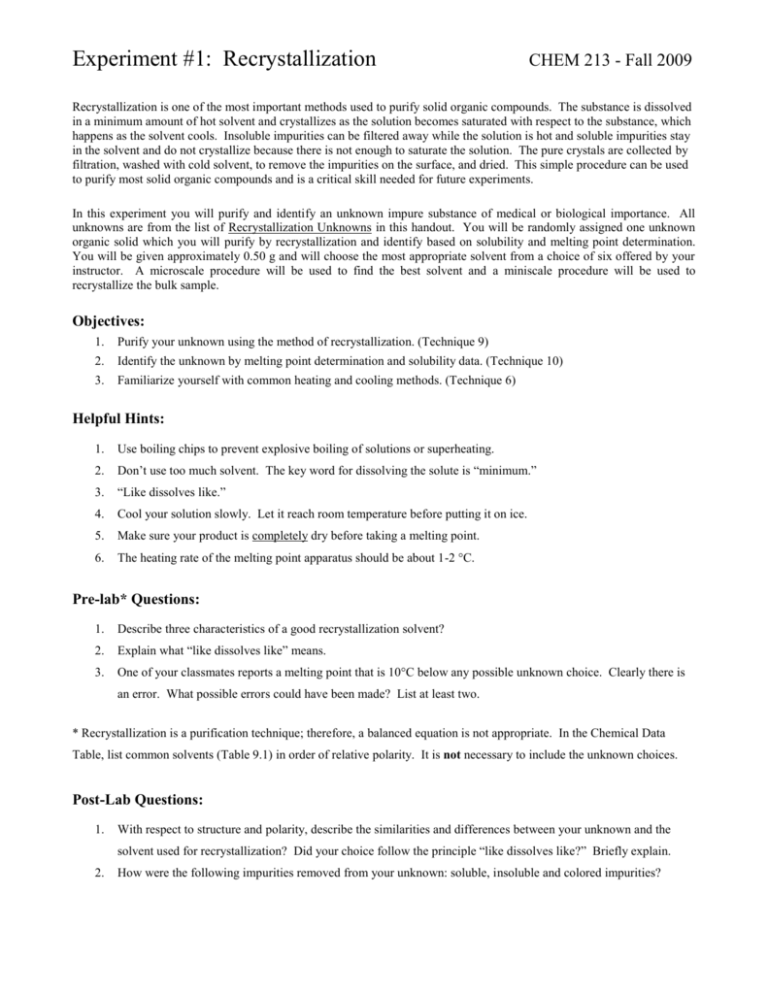
Experiment #1: Recrystallization CHEM 213 - Fall 2009 Recrystallization is one of the most important methods used to purify solid organic compounds. The substance is dissolved in a minimum amount of hot solvent and crystallizes as the solution becomes saturated with respect to the substance, which happens as the solvent cools. Insoluble impurities can be filtered away while the solution is hot and soluble impurities stay in the solvent and do not crystallize because there is not enough to saturate the solution. The pure crystals are collected by filtration, washed with cold solvent, to remove the impurities on the surface, and dried. This simple procedure can be used to purify most solid organic compounds and is a critical skill needed for future experiments. In this experiment you will purify and identify an unknown impure substance of medical or biological importance. All unknowns are from the list of Recrystallization Unknowns in this handout. You will be randomly assigned one unknown organic solid which you will purify by recrystallization and identify based on solubility and melting point determination. You will be given approximately 0.50 g and will choose the most appropriate solvent from a choice of six offered by your instructor. A microscale procedure will be used to find the best solvent and a miniscale procedure will be used to recrystallize the bulk sample. Objectives: 1. Purify your unknown using the method of recrystallization. (Technique 9) 2. Identify the unknown by melting point determination and solubility data. (Technique 10) 3. Familiarize yourself with common heating and cooling methods. (Technique 6) Helpful Hints: 1. Use boiling chips to prevent explosive boiling of solutions or superheating. 2. Don’t use too much solvent. The key word for dissolving the solute is “minimum.” 3. “Like dissolves like.” 4. Cool your solution slowly. Let it reach room temperature before putting it on ice. 5. Make sure your product is completely dry before taking a melting point. 6. The heating rate of the melting point apparatus should be about 1-2 C. Pre-lab* Questions: 1. Describe three characteristics of a good recrystallization solvent? 2. Explain what “like dissolves like” means. 3. One of your classmates reports a melting point that is 10°C below any possible unknown choice. Clearly there is an error. What possible errors could have been made? List at least two. * Recrystallization is a purification technique; therefore, a balanced equation is not appropriate. In the Chemical Data Table, list common solvents (Table 9.1) in order of relative polarity. It is not necessary to include the unknown choices. Post-Lab Questions: 1. With respect to structure and polarity, describe the similarities and differences between your unknown and the solvent used for recrystallization? Did your choice follow the principle “like dissolves like?” Briefly explain. 2. How were the following impurities removed from your unknown: soluble, insoluble and colored impurities? Recrystallization Unknowns Name (mp C) CHEM 213 - Fall 2009 Name (mp C) Structure Structure O acetaminophen (169-170) CH3CONH OH transcinnamic acid (133-134) H C C COH H O ibuprofen (75-77) NHCCH3 acetanilide (113-115) anthracene (216-218) CH3 (CH3)2CHCH2 CHCOOH naphthalene (80-82) OH O benzoic acid (121-123) 1-naphthol (96) COH CH3 O benzophenone (49-51) naproxen (152-154) C CHCOOH CH3O O biphenyl (69-72) phthalic acid (205 d) O H3C caffeine (234-237) N COH OH N N O CH3 COH O salicylic acid (158-160) N O COH CH3 H3C H3C cholesterol (148-150) H3C O CH3 CH CH3 vanillin (81-82) OCH3 HO OH
